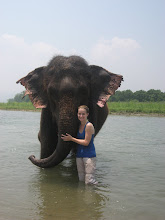Today there are strikes, called “bandh,” across Kathmandu, so the government, schools, and most businesses are closed for the day. There are only a few of us at ECCA –mainly the people who live close enough to walk or use their bicycle. Strikes in Nepal are actually quite fascinating, and relatively peaceful. The strikes today are in protest to a ruling that the Nepali government made two years ago that the official language across Nepal be Nepali, not the local ethnic language. In Kathmandu, the Newars are the highest class (and caste) in society and as such, are protesting the fact that Newari is not the official language of Kathmandu.
Or, at least that’s how I understand it. But I’m finding that you can ask five Nepalis the same question and get five different answers, so for all I know this strike is about something totally different. Anyway, the city was so quiet and empty on the way to work today because there are no vehicles running. The police and military are out in full force, but besides people hanging flags to show their support, not much is happening in my part of Kathmandu. The strikers are in other parts of the city, not where I live or work. From what I hear, even these strikes are relatively peaceful and organized. Nonetheless, foreigners are well respected here so I’m not too concerned one way or another. Nepal is an interesting place.
I’m leaving tomorrow for South Lalitpur for three days of travel through three villages to the South. ECCA has programs in the schools in these villages, so I am traveling alongside ECCA staff member Binod as he observes the projects going on in the schools. We’ll be meeting up with a group of ECCA field staff that are monitoring all 11 villages in the region. It’ll be a good time for me to start my research, in theory, on the role of conflict in child development in Nepal. Also, I get to hike through the hills to visit two of the villages, which I’m pretty excited about.
On Friday I went to Swayambhunath (also called the Monkey Temple) on the western part of Kathmandu. It was constructed hundreds, maybe thousands, of years ago in honor of Buddha. Like everything else in Nepal, there is a lot of mysticism and folklore surrounding the the temple. According to legend (and archeology), this area was once a huge lake. Upon visiting the valley, Buddha drained the water from the region standing on the hill where the temple is now located.
I am not so much a fan of monkeys, but these little dudes were all over the place, which was pretty cool. Swayambhunath also offers a beautiful view of the valley.
There is also a Hindu temple on this site. Though two separate religions, Hindus accepts Buddhism as part of Hinduism. It’s quite interesting. There’s a lot of other meaning behind this place, but I’ll allow the pictures to speak for themselves.
Love, Lisa
See? I'm really in Nepal! It's impossible to capture everything on this site in one photo. The temple is the white and gold dome, but there are a number of other statues and smaller temples as well. The Buddha's eyes are watching in every direction.
Another part of the temple site. It's incredibly high off the ground and you have to climb up quite a few stairs to get there. There are Tibetan prayer flags EVERYWHERE - it's beautiful. There are a number of monks that live here and are responsible for upkeep on the temple and the grounds. There's also trash everywhere. Shocking, right?






That monkey is totally eyeing your cute scarf.
ReplyDelete